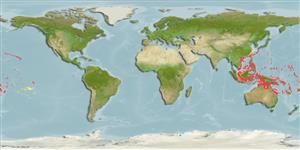Common names from other countries
>
Acanthuriformes (Surgeonfishes) >
Acanthuridae (Surgeonfishes, tangs, unicornfishes) > Acanthurinae
Etymology: Zebrasoma: Derived from Zebra = African horse + Greek, soma = body; referring to the stripes (Ref. 45335).
More on author: Bennett.
Environment: milieu / climate zone / depth range / distribution range
Ecologia
marinhas associadas(os) a recifes; intervalo de profundidade 2 - 46 m (Ref. 9710), usually 3 - 46 m (Ref. 27115). Tropical; 24°C - 28°C (Ref. 27115); 30°N - 25°S, 105°E - 137°W
Pacific Ocean: Ryukyu, Mariana, Marshall, Marcus, Wake and Hawaiian islands. Has been reported off the coast of Florida in the Western Central Atlantic (Ref. 51238).
Comprimento de primeira maturação / Tamanho / Peso / Idade
Maturity: Lm 6.3 range ? - ? cm
Max length : 20.0 cm TL macho/indeterminado; (Ref. 9710)
Espinhos dorsais (total) : 5; Raios dorsais (total) : 23 - 26; Espinhos anais: 3; Raios anais : 19 - 22. bright yellow overall (pale in preservative). Sheath of peduncular spine white. Body very deep, its depth 1.4 to 1.75 times in SL. Snout moderately protruding. Mouth small; teeth spatulate, close-set, the edges denticulate. 12 upper and 14 lower teeth in juveniles, and 18 upper and 22 lower teeth in an adult 15 cm SL (Ref 9808).
Adults inhabit coral-rich areas of lagoon and seaward reefs from below the surge zone to about 46 m (Ref. 9710). Benthopelagic over rock at 1-81 m (Ref. 58302). They occur singly or in loose groups. Mainly herbivorous, browsing on filamentous algae. Group spawning and pair-spawning by territorial males that court passing females were observed. Spawning activity occurs around the full moon indicating lunar periodicity (Ref. 86544). Spawn in batches throughout the year (Ref. 86544). Presence of a venom gland could not be determined despite the presence of distinct anterolateral grooves; this may be due to the loss of venom glands in adults (Ref. 57406). A popular aquarium fish and the top marine fish export from Hawaii.
Paired spawning (Ref. 240). Multiple spawner with reproductive activity occuring around the full moon (Ref. 86544).
Myers, R.F., 1991. Micronesian reef fishes. Second Ed. Coral Graphics, Barrigada, Guam. 298 p. (Ref. 1602)
Status na Lista Vermelha da UICN (Ref. 130435)
CITES (Ref. 128078)
Not Evaluated
Ameaça para os humanos
Harmless
Uso pelos humanos
Pescarias: espécies comerciais; Aquário: Espécies comerciais
Ferramentas
Relatórios especiais
Baixar XML
Fontes da internet
Estimates based on models
Preferred temperature (Ref.
115969): 24.9 - 28.9, mean 27.6 (based on 614 cells).
Índice de diversidade filogenética (Ref.
82804): PD
50 = 0.5078 [Uniqueness, from 0.5 = low to 2.0 = high].
Bayesian length-weight: a=0.01950 (0.01203 - 0.03160), b=2.98 (2.84 - 3.12), in cm Total Length, based on LWR estimates for this species & (Sub)family-body (Ref.
93245).
Nível Trófico (Ref.
69278): 2.0 ±0.00 se; based on food items.
Resiliência (Ref.
120179): Elevada, tempo mínimo de duplicação da população menor que 15 meses (K=0.25; Fec > 10,000).
Fishing Vulnerability (Ref.
59153): High vulnerability (57 of 100).
